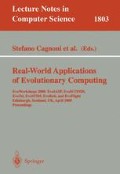Abstract
A hybrid approach for learning reactive behaviours is presented in this work. This approach is based on combining evolutionary algorithms (EAs) with the A* algorithm. Such combination is done within the framework of Dynastically Optimal Forma Recombination, and tries to exploit the positive features of EAs and A* (e.g., implicit parallelism, accuracy and use of domain knowledge) while avoiding their potential drawbacks (e.g., premature convergence and combinatorial explosion). The resulting hybrid algorithm is shown to provide better results, both in terms of quality and in terms of generalisation.
Access this chapter
Tax calculation will be finalised at checkout
Purchases are for personal use only
Preview
Unable to display preview. Download preview PDF.
References
K. Ali and A. Goel. Combining navigational planning and reactive control. In Theories of Action, Planning, and Robot Control. Bridging the Gap: Proceedings of the 1996 AAAI Workshop, pages 1–9, Menlo Park, CA, 1996. AAAI Press.
C.T.C. Arsene and A.M.S. Zalzala. Control of autonomous robots using fuzzy logic controllers tuned by genetic algorithms. In Proceedings of the 1999 Congress on Evolutionary Computation, pages 428–435. IEEE NNC-EP Society-IEE, 1999.
T.D. Barfoot and D’Eleuterio G.M.T. An evolutionary approach to multiagent heap formation. In Proceedings of the 1999 Congress on Evolutionary Computation, pages 420–427. IEEE NNC-EP Society-IEE, 1999.
C. Cotta, E. Alba, and J.M. Troya. Utilising dynastically optimal forma recombination in hybrid genetic algorithms. In A.E. Eiben, Th. Bäck, M. Schoenauer, and H.-P. Schwefel, editors, Parallel Problem Solving From Nature V, volume 1498 of Lecture Notes in Computer Science, pages 305–314. Springer-Verlag, Berlin, 1998.
C. Cotta and J.M. Troya. Tackling epistatic problems using dynastically optimal recombination. In B. Reusch, editor, Computational Intelligence. Theory and Applications, volume 1625 of Lecture Notes in Computer Science, pages 197–205. Springer-Verlag, Berlin Heidelberg, 1999.
L. Davis. Handbook of Genetic Algorithms. Van Nostrand Reinhold Computer Library, New York, 1991.
J.-Y. Donnart and J.-A. Meyer. Learning reactive and planning rules in a motivationally autonomous animat. IEEE Transactions on Systems, Man, and Cybernetics, 26(3):381–195, 1996.
F. Hoffmann and G. Pfister. Learning of a fuzzy control rule base using messy genetic algorithms. In F. Herrera and J.L. Verdegay, editors, Genetic Algorithms and Soft Computing, pages 279–305. Physica-Verlag, Heidelberg, 1996.
J.R. Koza. Genetic Programming. MIT Press, Cambridge MA, 1992.
N.J. Radcliffe. The algebra of genetic algorithms. Annals of Mathematics and Artificial Intelligence, 10:339–384, 1994.
A.C. Schultz and J.J. Grefenstette. Using a genetic algorithm to learn behaviours for autonomous vehicles. In Proceedings of the AIAA Guidance, Navigation and Control Conference, pages 739–749, Hilton Head SC, 1992.
C. Thornton. Learning where to go without knowing where that is: the acquisition of a non-reactive mobot behaviour by explicitation. Technical Report CSRP-361, School of Cognitive and Computing Sciences, University of Sussex, 1994.
G. Weiss. Multiagents Systems: a Modern Approach to Distributed Artificial Intelligence. The MIT Press, Cambridge MA, 1999.
D.H. Wolpert and W.G. Macready. No free lunch theorems for search. Technical Report SFI-TR-95-02-010, Santa Fe Institute, 1995.
B. Yamauchi and R. Beer. Integrating reactive, sequential and learning behaviour using dynamical neural networks. In D. Cliff, P. Husbands, J.-A. Meyer, and S. Wilson, editors, From Animals to Animats 3: Proceedings of the Third International Conference on Simulation of Adaptive Behaviour, pages 382–391, Cambridge MA, 1994. MIT Press/Bradford Books.
Author information
Authors and Affiliations
Editor information
Editors and Affiliations
Rights and permissions
Copyright information
© 2000 Springer-Verlag Berlin Heidelberg
About this paper
Cite this paper
Cotta, C., Troya, J.M. (2000). Using a Hybrid Evolutionary-A* Approach for Learning Reactive Behaviours. In: Cagnoni, S. (eds) Real-World Applications of Evolutionary Computing. EvoWorkshops 2000. Lecture Notes in Computer Science, vol 1803. Springer, Berlin, Heidelberg. https://doi.org/10.1007/3-540-45561-2_34
Download citation
DOI: https://doi.org/10.1007/3-540-45561-2_34
Published:
Publisher Name: Springer, Berlin, Heidelberg
Print ISBN: 978-3-540-67353-8
Online ISBN: 978-3-540-45561-5
eBook Packages: Springer Book Archive

